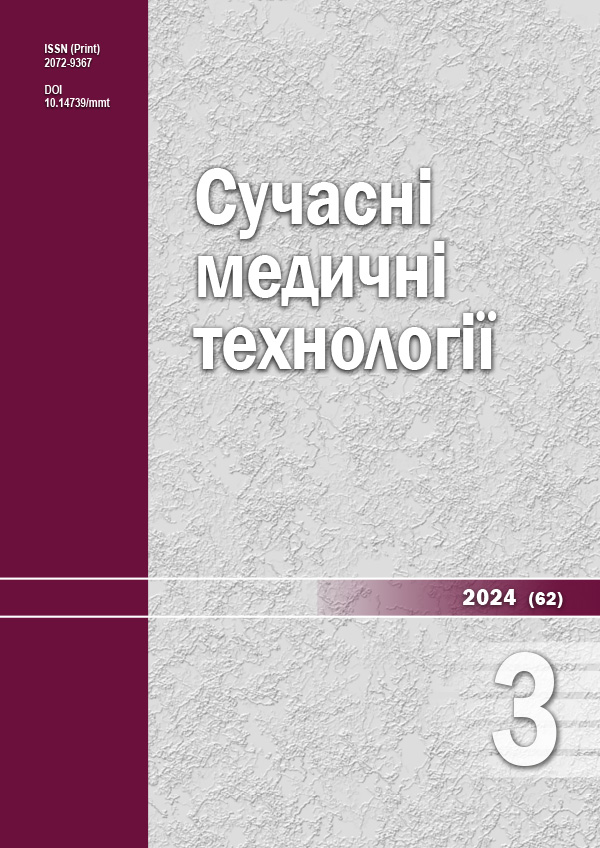The influence of occlusive-stenotic lesions of the arteries of the head and neck on the methods and results of surgical treatment of ruptured arterial aneurysms
DOI:
https://doi.org/10.14739/mmt.2024.3.309136Keywords:
arterial aneurysm, occlusive-stenotic lesions, cerebral arteries, brachiocephalic trunk, operative surgical proceduresAbstract
Aim: to analyze the results of surgical treatment of patients with ruptured arterial aneurysms in the presence of occlusive-stenotic lesions of cerebral arteries and to evaluate the impact of combined lesions on the choice of surgical treatment method.
Materials and methods. A retrospective study was conducted on the medical histories of patients with aneurysmal disease of cerebral arteries from 2006 to 2022. The main group consisted of 63 patients with occlusive-stenotic lesions of cerebral arteries who underwent surgery for ruptured arterial aneurysm. The comparison group included 63 patients without occlusive-stenotic lesions. The analysis included an assessment of neurological status, examination results, and statistical data processing.
Results. Occlusive-stenotic lesions of the head and neck arteries were more frequently observed in men, the maximum difference in age was found at a stenosis of 50–75 % (men – 48.30 ± 2.51 years; women – 62.00 ± 5.06 years, p < 0.01). Cerebral artery stenosis was more commonly observed in cases of ruptured middle cerebral artery aneurysms. The main group had more fatal cases (n = 5) compared to the comparison group (n = 2), p = 0.25.
Conclusions. Ruptured arterial aneurysms are more frequently diagnosed in the presence of middle cerebral artery stenosis (p < 0.05). Ruptured aneurysms in patients with occlusive-stenotic lesions of cerebral arteries are more often diagnosed in middle age (p = 0.0001). The combination of stenosis and aneurysm complicates the disease course and affects the choice of surgical method. Patients with combined lesions have a higher risk of ischemic complications (p = 0.03). The greatest life risks arise from ruptured arterial aneurysms in men with concomitant arterial stenosis. The main risk factors are occlusive-stenotic lesions of the arteries, recurrent hemorrhages, and large intracranial hemorrhages.
References
Zhao HY, Fan DS, Han JT. [Management of severe internal carotid stenosis with unruptured intracranial aneurysm]. Beijing Da Xue Xue Bao Yi Xue Ban. 2019;51(5):829-834. Chinese. doi: https://doi.org/10.19723/j.issn.1671-167X.2019.05.007
Tallarita T, Sorenson TJ, Rinaldo L, Oderich GS, Bower TC, Meyer FB, et al. Management of carotid artery stenosis in patients with coexistent unruptured intracranial aneurysms. J Neurosurg. 2019;132(1):94-7. doi: https://doi.org/10.3171/2018.9.JNS182155
Werner C, Mathkour M, Scullen T, Mccormack E, Dumont AS, Amenta PS. Multiple flow-related intracranial aneurysms in the setting of contralateral carotid occlusion: Coincidence or association? Brain Circ. 2020;6(2):87-95. doi: https://doi.org/10.4103/bc.bc_1_20
Cortese J, Caroff J, Chalumeau V, Gallas S, Ikka L, Moret J, et al. Determinants of cerebral aneurysm occlusion after embolization with the WEB device: a single-institution series of 215 cases with angiographic follow-up. J Neurointerv Surg. 2023;15(5):446-51. doi: https://doi.org/10.1136/neurintsurg-2022-018780
Fortunel A, Javed K, Holland R, Ahmad S, Haranhalli N, Altschul D. Impact of aneurysm diameter, angulation, and device sizing on complete occlusion rates using the woven endobridge (WEB) device: Single center United States experience. Interv Neuroradiol. 2023;29(3):260-7. doi: https://doi.org/10.1177/15910199221084804
Kewlani B, Ryan DJ, Henry J, Wyse G, Fanning N. A single centre retrospective analysis of short- and medium-term outcomes using the Woven EndoBridge (WEB) device and identification of the device-to-aneurysm volume ratio as a potential predictor of aneurysm occlusion status. Interv Neuroradiol. 2023;29(4):393-401. doi: https://doi.org/10.1177/15910199221092578
Hiramatsu R, Ohnishi H, Yagi R, Kuroiwa T, Wanibuchi M, Miyachi S. A Patient with a Large Aneurysm Complicated by Stenosis of the Internal Carotid Artery Distal to the Aneurysm in Whom Treatment Using a Pipeline Flex Was Performed. J Neuroendovasc Ther. 2020;14(11):501-7. doi: https://doi.org/10.5797/jnet.cr.2019-0129
Yee S, Portalatin M, Sridhar M, Perrone J, Adunbarin A, Guerrero M, et al. Fatal Subarachnoid Hemorrhage From Ruptured Intracerebral Aneurysm After Carotid Endarterectomy. J Med Cases. 2020;11(1):12-5. doi: https://doi.org/10.14740/jmc3403
Cherednychenko Y, Engelhorn T, Miroshnychenko A, Zorin M, Dzyak L, Tsurkalenko O, et al. Endovascular treatment of patient with multiple extracranial large vessel stenosis and coexistent unruptured wide-neck intracranial aneurysm using a WEB device and Szabo-technique. Radiol Case Rep. 2020;15(12):2522-9. doi: https://doi.org/10.1016/j.radcr.2020.09.020
Hurford R, Taveira I, Kuker W, Rothwell PM; Oxford Vascular Study Phenotyped Cohort. Prevalence, predictors and prognosis of incidental intracranial aneurysms in patients with suspected TIA and minor stroke: a population-based study and systematic review. J Neurol Neurosurg Psychiatry. 2021;92(5):542-8. doi: https://doi.org/10.1136/jnnp-2020-324418
Wajima D, Nakagawa I, Wada T, Nakase H. A Trial for an Evaluation of Perianeurysmal Arterial Pressure Change during Carotid Artery Stenting in Patients with Concomitant Severe Extracranial Carotid Artery Stenosis and Ipsilateral Intracranial Aneurysm. Turk Neurosurg. 2019;29(5):785-8. doi: https://doi.org/10.5137/1019-5149.JTN.20418-17.0
Ni H, Zhong Z, Zhu J, Jiang H, Hu J, Lin D, et al. Single-Stage Endovascular Treatment of Severe Cranial Artery Stenosis Coexisted With Ipsilateral Distal Tandem Intracranial Aneurysm. Front Neurol. 2022;13:865540. doi: https://doi.org/10.3389/fneur.2022.865540
Toki N, Matsumoto H, Nishiyama H, Izawa D. Cerebral Aneurysm Coil Embolization with a Coil-Assisted Technique Using a Small-Diameter Helical Coil. J Neuroendovasc Ther. 2022;16(6):335-8. doi: https://doi.org/10.5797/jnet.tn.2021-0016
Tsuji Y, Kuroda Y, Wanibuchi M. Coil embolization for ruptured distal anterior cerebral artery aneurysm at the supracallosal portion: Two case reports. Surg Neurol Int. 2023;14:444. doi: https://doi.org/10.25259/SNI_810_2023
Campos JK, Lin LM, Beaty NB, Bender MT, Jiang B, Zarrin DA, et al. Tandem cervical carotid stenting for stenosis with flow diversion embolisation for the treatment of intracranial aneurysms. Stroke Vasc Neurol. 2018;4(1):43-7. doi: https://doi.org/10.1136/svn-2018-000187
Downloads
Additional Files
Published
How to Cite
Issue
Section
License
The work is provided under the terms of the Public Offer and of Creative Commons Attribution-NonCommercial 4.0 International (CC BY-NC 4.0). This license allows an unlimited number of persons to reproduce and share the Licensed Material in all media and formats. Any use of the Licensed Material shall contain an identification of its Creator(s) and must be for non-commercial purposes only.














